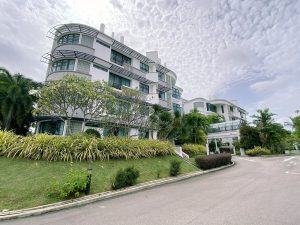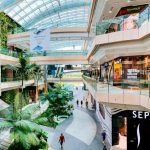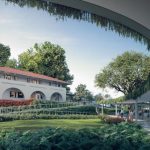Queen Astrid Gardens – Sprawling, Elevated Land in Good Class Bungalow Area Launched for Sale by Tender
Knight Frank Singapore on 3rd September, announced the launch of the sale of Queen Astrid Gardens by tender. Knight Frank Singapore is the exclusive marketing agent of the Good Class Bungalow (GCB), residential redevelopment land situated in the Queen Astrid Park Good Class Bungalow Area (GCBA).
Queen Astrid Gardens is a 999-year leasehold condominium with an existing four-storey residential development comprising 16 residential apartments ranging from 224 sq m to 239 sq m. It has a site area of 5,782.6 sq m (approx. 62,243 sq ft).
Table of Contents

Situated in one of the most prestigious GCB enclaves among the 39 gazetted GCBAs in Singapore, Queen Astrid Gardens sits on elevated grounds and is possibly the highest point in the locality.
The current development has a generous frontage of more than 100 metres onto Queen Astrid Gardens. Besides the potential to retain its current use as apartments, it also allows for a single mansion to be built or can be subdivided up to four GCB parcels, subject to approval by the relevant authorities.
The owners of Queen Astrid Gardens expect offers above the guide price of S$126.8 million for the unique and expansive land, which translates to approximately S$2,037 psf on the land area.
Mr K. Chong, Chairman of the Collective Sale Committee of Queen Astrid Gardens, comments, “I had originally purchased my unit with plans for retirement there, being a large apartment unit in a private and serene area, with a nice view that overlooks the roofs and treeline of the neighbouring estate. I feel the site has all the right attributes for a GCB, and such properties are getting increasingly hard to come by. I believe interested parties will see the value in this site.”
Mr Ian Loh, Head of Capital Markets for Land & Building, Collective & Strata Sales, Knight Frank Singapore, shares, “Queen Astrid Gardens poses opportunities for potential buyers looking to create a family estate and leave an enduring legacy. There are only about 2,800 GCBs in the 39 safeguarded GCBAs in Singapore, and the last GCB transaction in District 10 of land more than 60,000 sq ft in size transpired more than five years ago, in June 2015.
“With a very limited supply, GCBs with favourable attributes such as regular-shaped land and elevated grounds usually command good premiums over other GCBs. With the option for subdivision into several GCBs, the asset is an especially attractive proposition for home-seekers or investors looking for further wealth preservation potential, over the long term.”
The tender for Queen Astrid Gardens will close on 7 October 2020, Wednesday at 3.00 pm.
GCBs have been in the spotlight since news broke recently that Sir Dyson had forked out $41 million for a hilltop GCB located along Cluny Road with views of the Botanic Gardens, Singapore’s first and only UNESCO Heritage Site.
List Sotheby’s International Realty (List SIR) which reported on the purchase of Sir Dyson, noted that what makes this GCB deal an even greater surprise is that landed properties in Singapore, including the 2,800 plots located in the 39 GCB areas gazetted by the Urban Redevelopment Authority (URA), are classified as restricted properties and are limited for purchase and ownership by Singapore Citizens only. Besides their rarity, GCBs also come with strict planning conditions stipulated by the URA to preserve their exclusivity and low-rise character.
Even ultra high net worth investors, such as the Dysons, need to get special approval from the government to purchase and own GCBs because they are permanent residents. Criteria include making exceptional economic contributions in Singapore and the buyer can only use the GCB for owner occupation.
According to the Singapore Residential Property Act, foreigners are not allowed to own landed properties, which include bungalows. However, foreigners are allowed to own the bungalows at Sentosa Cove, a planned resort island to attract high-net-worth (HNW) foreign investors. Foreigners are allowed to own apartments in Singapore.
In 2019, a GCB plot in the prestigious Nassim Road area was bought by SG Casa Pte Ltd for a record $230 million. The price for the sprawling land of 84,543 sq ft land works out to be S$2,721 psf. The plot of lands comes with a two-storey bungalow, a tennis court and swimming pool. The site has a road frontage that is nearly 100m, and can be redeveloped into four or five bungalows.
List SIR in referring to media report suggested that the party behind SG Casa could be Eduardo Saverin. Mr Saverin became a Singapore citizen in 2012.
Sir Dyson, who is chief executive of Dyson Ltd, had earlier bought the most expensive 99-year-leasehold penthouse situated on a 62nd to 64th floor in Wallich Residence. The three-storey penthouse comes complete with a private infinity pool, jacuzzi, barbecue pit, and private lift lobby.
Besides Dyson and Saverin, another famous name that has been making rounds in Singapore’s media landscape was Jack Ma, who is said to have purchased a 30,000 sq ft site at Victoria Park Close. The Alibaba co-founder is supposedly building a two-storey bungalow with a basement and swimming pool.
The report by List SIR said, ” in light of the geopolitical tensions in Hong Kong and United Kingdom, there could be increased interest from more foreign ultra high net worth investors, the likes of Sir Dyson. Singapore’s solid economic fundamentals, sound financial framework, ease of doing business, quality education and racial harmony continue to make it one of the choice locations for potential foreign investors.”
Mr Paul Ho, chief mortgage consultant at iCompareLoan, said, “with political stability, it is understandable why Singapore looks attractive to ultra high net worth investors. Due to its limited supply and the prestige associated with these large bungalow plots, GCBs are often sought after by well-heeled individuals.”
He added, “Singapore’s business-friendly environment also attracts many ultra high net worth investors to park their assets here. Prices of GCBs have been on a steady increase since 2016 and so it is viewed as a good investment.”






